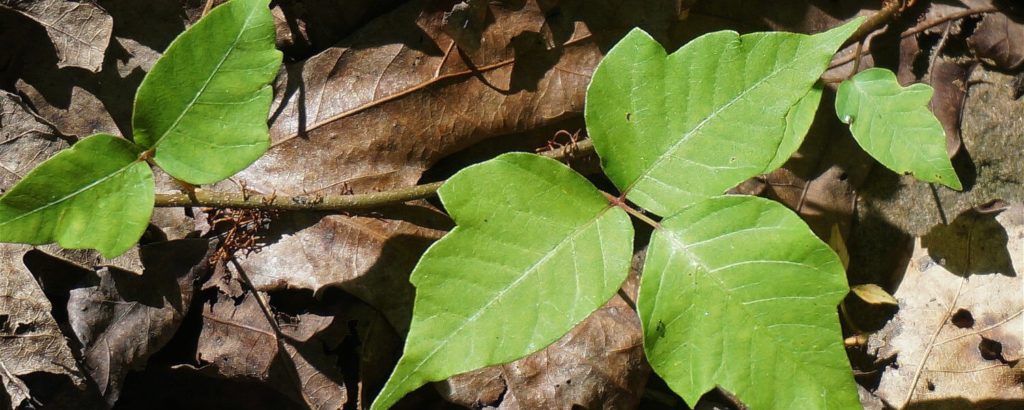Some plans can cause real problems to pets and people. We joke about plants like poison ivy and poison oak, but the reality is that a brush with many of these plans can land you in hospital.
Mississauga’s landscape contains many plants —wild and cultivated—that should make all gardeners and landscapers use caution.
Most Troublesome Plant Of All: Poison Ivy
If you’ve ever done business with a poison ivy plant, you won’t be surprised that this one tops our list of troublesome plants.
Did you know that the oil that it secretes—called urushiol—is so potent that it can take less than a pinhead worth to set off a full blown reaction?
And by reaction, we’re talking unspeakably itchy rashes with liquid filled blisters. Worse still, while it won’t affect your pets, if they walk through a patch, they can get the oil on their fur and transfer it to you.
Poison Ivy can be found throughout Southern Ontario, and it can grow in all sorts of conditions: deep woods, rocky or sandy areas, road sides, open clearings and so on. It is a climbing perennial characterized by three leaves with jagged nodes, with the middle leaf having a longer stalk.
If you have some growing in your yard, get rid of it immediately by removing it at the root, while wearing protective clothing, placing all the plant parts in a garbage bag and sealing them.
A warning: Don’t ever burn poison ivy. The smoke can carry the effects of the oil and can cause incredibly painful lung damage as the rash occurs internally.
Runner Up: Hemlock
While less common than poison ivy, there are two species of hemlock that can harm people and animals: spotted water hemlock and poison hemlock.
The roots of the former are very similar to parsnips and are often confused with the benign water parsnip. The difference is in what the roots contain, however. Spotted water hemlock contains Cicutoxin.
This poison is strong enough that one root can kill horses and livestock; at the very least, they would be plagued by vomiting, convulsions and severe cramping. In a large quantity, they can even cause central nervous system damage and even death.
Poison hemlock has the dubious distinction of having been used in ancient Greece, to do away with prisoners and even Socrates himself is said to have died from being poisoned with it. It is a weed that wasn’t native to Ontario but instead was brought here in the 1980s, along with some non-native alfalfa. The results of eating it are devastating, with a neurotoxin that will disrupt the central nervous system.
While it’s unlikely that anyone would plant either of these in their gardens, they can grow wild in larger acreages, so it’s something to watch for.
A Few More Troublesome Flowers And Plants
Here are a few more that are worth skipping, or at least being aware of, as you plan your garden:
- Castor Beans — an ornamental shrub with seed pods that contain ricin, a chemical that is VERY toxic, even in small quantities.
- Amaryllis — ingesting the bulbs that contain lycorine can be dangerous.
- Mistletoe and Holly — while these are holiday favourites and you’d have to eat quite a few of the berries to be ill, it wouldn’t take a lot of these to make kids and pets quite ill.
- Easter Lily — the leaves and bulbs are appealing to cats in particular, but will cause renal failure and almost certain death if ingested by your feline friends!
- Canadian Nettle — while more of a wild growth, the stinging hairs on it can get under your skin and leave a nasty itchy rash that can last for weeks.
For a comprehensive list of poisonous plants, see the Canadian Poisonous Plants Information System, for details on which plants are poisonous and what damage they can cause. If you’re interested in a good read on the subject, Amy Stewart’s “Wicked Plants: The Weed That Killed Lincoln’s Mother and Other Botanical Atrocities” is worth picking up. It’s an A to Z compendium of evil plants the world over.
“Betony has a long and storied history as a magical and medicinal plant dating back to Roman and ancient Egyptian times. In fact, it was often planted in graveyards to prevent the activities of ghosts and worn in an amulet as a charm against evil spirits.” (Source)
It’s important when you consider what you’re adding to your garden not to include plants that have serious toxicity within their leaves, stems, berries or bulbs, particularly if you have children and animals about.
Take care to keep troublesome plants at bay and plan a garden for next spring that is safe for everyone to enjoy!

